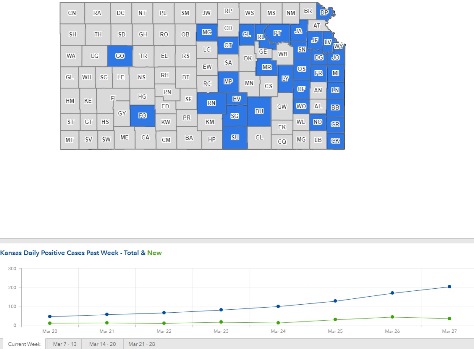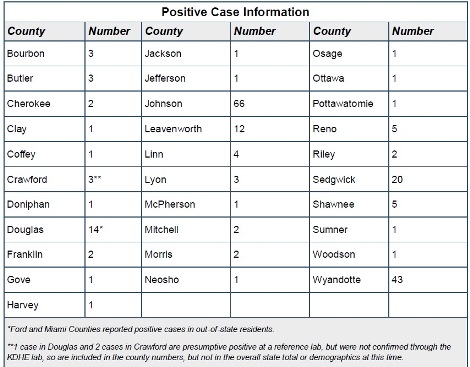Gov. Laura Kelly announced on Saturday that a temporary stay-at-home order would be implemented for the entire state of Kansas beginning at 12:01 a.m. Monday, March 30, and lasting until at least April 19 because of the COVID-19 pandemic.
In an announcement in Topeka, and carried on the governor’s Facebook page at https://www.facebook.com/GovLauraKelly/, the governor announced a “stay-at-home” order similar to the one already in place for Wyandotte, Johnson, Douglas, Leavenworth and Sedgwick counties. Twenty-two other states also have issued temporary “stay-at-home” orders.
Wyandotte County has 47 positive COVID-19 cases and three deaths related to COVID-19 as of Friday, according to information from the Unified Government Health Department. The state of Kansas reported 202 positive COVID-19 cases on Friday morning.
“I know this is hard, and I can’t tell you how much I wish it weren’t necessary,” Gov. Kelly said. “But we have a small window to ensure that Kansas does not suffer the same terrible fate of other hard-hit states like New York and Missouri. We’ve all got to do our part to help stop the spread of the disease. Stay home. Stay Safe.”
More than half the state’s population already is under “stay-at-home” orders, she said.
Under this state order, residents will stay home unless going to work at an essential job, or performing an essential task such as obtaining food, medication or other household necessities. Residents may go out to seek medical care, caring for children, pets and family members. Exercising outside is allowed, six feet apart, but the maximum limit of any group is 10.
There are provisions for businesses and their operation in the new order announced today, that are similar, with some differences in the details, from earlier orders in Wyandotte County. While there are essential businesses and functions specifically mentioned in the order, people in nonessential businesses can continue to work at home if they can.
The state order will supersede all local orders, according to the language in the document, meaning that the Wyandotte County “stay-at-home” orders will no longer be in effect on March 30, but are replaced by the state “stay-at-home” orders. The local orders will still be in effect Saturday and Sunday. When the state order ends April 19, the local orders will resume again if there is still time left on them, such as Wyandotte County’s order, which ends April 23.
State health officials on Friday morning reported that positive COVID-19 cases had climbed to 202 in Kansas, and they projected cases to reach about 900 by March 31 in the state, Gov. Kelly noted.
The Wyandotte County order has been in effect since Tuesday, March 24, with an end date of April 23. The local order will continue after the state order is lifted April 19.
The governor said the state’s first position will be to let Kansans monitor themselves with the “stay-at-home” order, but local law enforcement can act concerning those not staying at home.
About 24,000 people have filed for unemployment in Kansas just in the past week, a rate that is about 12 times higher than the past unemployment numbers, Gov. Kelly said. She commended efforts in the federal stimulus and relief legislation passed Friday to help alleviate the needs of those who are unemployed. Also, action has been taken to extend the number of weeks people are eligible for unemployment benefits.
Gov. Kelly said the state will scale up its COVID-19 testing capacity as quickly as possible. She said there are indications that there are positive cases everywhere, not just in Wyandotte, Johnson and Sedgwick counties.
The state is expected to re-evaluate the order around April 19 to see if it should be extended.
Vulnerable hospitals, including rural hospitals, need more time to prepare, and this order is expected to protect those hospitals and their workers by giving them more time, she said, as well as protecting residents from COVID-19.
Kansas has not received as much personal protective equipment from the federal government as it wants, and the state will continue to press the federal government for more equipment, she said.
At the same time, Kansas is working with private companies in the state to produce more protective equipment, she said.
According to the order, no one will need to carry papers or documents saying they are allowed to perform a function or activity. Law enforcement officers are asked to use their discretion and consider the totality of the circumstances as they determine appropriate enforcement action, according to the state order released today.
Also, prior approval is not required for those listed as performing essential functions in the order. “Those who are uncertain whether they perform functions exempted from the prohibitions of the order may email [email protected] to determine whether their functions are deemed essential,” the order stated. The order specifically lists the functions that are “essential.”
Gov. Kelly’s “stay-at-home” order, Executive Order No. 20-16, is online at https://governor.kansas.gov/executive-order-no-20-16/.
To see the video of Gov. Kelly’s “stay-at-home” announcement, visit Facebook page at https://www.facebook.com/GovLauraKelly/.
To see a news release about the governor’s “stay-at-home” order, visit https://governor.kansas.gov/governor-kelly-issues-temporary-statewide-stay-home-order-in-ongoing-effort-to-combat-covid-19/.
More information is on the website of the Kansas Department of Health and Environment at https://govstatus.egov.com/coronavirus.


